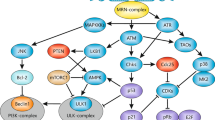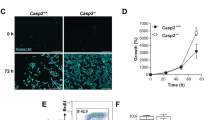Abstract
DNA fragmentation factor (DFF)/caspase-activated DNase (CAD) is responsible for DNA fragmentation, a hallmark event during apoptosis. Although DNA fragmentation is an evolutionarily conserved process across species, its biological function is not clearly understood. In this study, we constructed cell lines expressing a mutant ICAD (inhibitor of CAD) protein that is resistant to caspase cleavage and therefore constantly binds to DFF/CAD and inhibits DNA fragmentation. We found that irradiation of these cells led to increased chromosome aberrations and aneuploidy when compared with their parental controls. The increased chromosome instability is observed irrespective of cellular P53 status, suggesting that the effect of DFF/CAD is independent of P53. Inhibition of apoptotic DNA fragmentation resulted in increased clonogenic survival of irradiated cells and a delay in removal of cells with DNA damages induced by radiation, an effect similar to that in cells with p53 mutations. Consistent with DFF/CAD's effect on clonogenic survival, tumors established from cells deficient in DNA fragmentation showed enhanced growth in nude mice. Therefore, our results suggest that DFF/CAD plays an important and P53-independent role in maintaining chromosome stability and suppressing tumor development.
This is a preview of subscription content, access via your institution
Access options
Subscribe to this journal
Receive 50 print issues and online access
$259.00 per year
only $5.18 per issue
Buy this article
- Purchase on Springer Link
- Instant access to full article PDF
Prices may be subject to local taxes which are calculated during checkout





Similar content being viewed by others
References
Abel F, Sjoberg RM, Krona C, Nilsson S, Martinsson T . (2004). Int J Oncol 25: 1297–1302.
Abel FSR, Ejeskar K, Krona C, Martinsson T . (2002). Br J Cancer 86: 596–604.
Caron HvSP, de Kraker J, Bokkerink J, Egeler M, Laureys G, Slater R et al. (1996). N Engl J Med 334: 225–230.
Elledge SJ . (1996). Science 274: 1664–1672.
Enari M, Sakahira H, Yokoyama H, Okawa K, Iwamatsu A, Nagata S . (1998). Nature 391: 43–50.
Eshleman JR, Casey G, Kochera ME, Sedwick WD, Swinler SE, Veigl ML et al. (1998). Oncogene 17: 719–725.
Hoyt MA, Stearns T, Botstein D . (1990). Mol Cell Biol 10: 223–234.
Judson HvRN, Strain L, Vandesompele J, Van Gele M, Speleman F, Bonthron DT . (2000). Hum Genet 106: 406–413.
Kawane K, Fukuyama H, Yoshida H, Nagase H, Ohsawa Y, Uchiyama Y et al. (2003). Nat Immunol 4: 138–144.
Kinsella TM, Nolan GP . (1996). Hum Gene Ther 7: 1405–1413.
Konishi S, Ishiguro H, Shibata Y, Kudo J, Terashita Y, Sugiura H et al. (2002). Cancer 95: 2473–2478.
Lechardeur D, Drzymala L, Sharma M, Zylka D, Kinach R, Pacia J et al. (2000). J Cell Biol 150: 321–334.
Lengauer C, Kinzler KW, Vogelstein B . (1997). Nature 386: 623–627.
Lengauer C, Kinzler KW, Vogelstein B . (1998). Nature 396: 643–649.
Li LY, Luo X, Wang X . (2001). Nature 412: 95–99.
Liber HL, Thilly WG . (1982). Mutat Res 94: 467–485.
Little JB, Nagasawa H, Keng PC, Yu Y, Li CY . (1995). J Biol Chem 270: 11033–11036.
Liu X, Zou H, Slaughter C, Wang X . (1997). Cell 89: 175–184.
Maris JM, White PS, Beltinger CP, Sulman EP, Castleberry RP, Shuster JJ et al. (1995). Cancer Res 55: 4664–4669.
Murray AW . (1995). Curr Opin Genet Dev 5: 5–11.
Nasmyth K . (1996). Trends Genet 12: 405–412.
Ohira M, Kageyama H, Mihara M, Furuta S, Machida T, Shishikura T et al. (2000). Oncogene 19: 4302–4307.
Paulovich AG, Toczyski DP, Hartwell LH . (1997). Cell 88: 315–321.
Sakahira H, Enari M, Nagata S . (1998). Nature 391: 96–99.
Schwab M, Praml C, Amler LC . (1996). Genes Chromosomes Cancer 16: 211–229.
Skopek TR, Liber HL, Penman BW, Thilly WG . (1978). Biochem Biophys Res Commun 84: 411–416.
Slane JM, Lee HS, Vorhees CV, Zhang J, Xu M . (2000). Brain Res 867: 70–79.
Spencer F, Gerring SL, Connelly C, Hieter P . (1990). Genetics 124: 237–249.
Van Gele MSF, Vandesompele J, Van Roy N, Leonard JH . (1998a). Cancer Res 58: 1503–1508.
Van Gele MVRN, Ronan SG, Messiaen L, Vandesompele J, Geerts ML, Naeyaert JM et al. (1998b). Genes Chromosomes Cancer 23: 67–71.
van Loo G, Schotte P, van Gurp M, Demol H, Hoorelbeke B, Gevaert K et al. (2001). Cell Death Differ 8: 1136–1142.
Yan B, Wang H, Peng Y, Hu Y, Wang H, Zhang X et al. (2006). Proc Natl Acad Sci USA 103: 1504–1509.
Yan B, Zemskova M, Holder S, Chin V, Kraft A, Koskinen PJ et al. (2003). J Biol Chem 278: 45358–45367.
Yandell DW, Little JB . (1986). Cancer Genet Cytogenet 20: 231–239.
Acknowledgements
We thank Dr Mike Cook and Thusitha Dissanayake of Duke University for assistance in flow cytometry analysis. We thank Drs Yulin Zhao, Yuqing Yuan and Zhonghui Yang of Duke University for their helpful input to this paper. This study was supported by a grant from the US Department of Defense Prostate Cancer Research Program (DAMD17-02-1-0052), a grant from the US Department of Energy Low Dose Research Program (DE-FG02-03ER63635) and a grant from the National Aeronautics and Space Administration (NAG2-1629).
Author information
Authors and Affiliations
Corresponding author
Rights and permissions
About this article
Cite this article
Yan, B., Wang, H., Wang, H. et al. Apoptotic DNA fragmentation factor maintains chromosome stability in a P53-independent manner. Oncogene 25, 5370–5376 (2006). https://doi.org/10.1038/sj.onc.1209535
Received:
Revised:
Accepted:
Published:
Issue Date:
DOI: https://doi.org/10.1038/sj.onc.1209535
Keywords
This article is cited by
-
Apoptosis-inducing activities of Halopteris scoparia L. Sauvageau (Brown algae) on cancer cells and its biosafety and antioxidant properties
Cytotechnology (2019)
-
A synthetic uracil derivative with antitumor activity through decreasing cyclin D1 and Cdk1, and increasing p21 and p27 in MCF-7 cells
Breast Cancer Research and Treatment (2007)
-
Regulation of mammalian horizontal gene transfer by apoptotic DNA fragmentation
British Journal of Cancer (2006)



